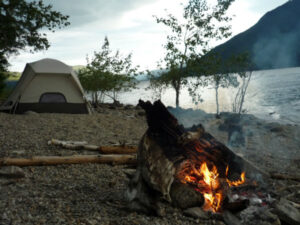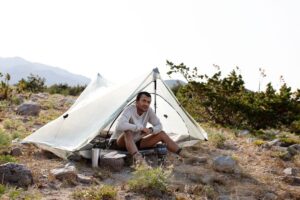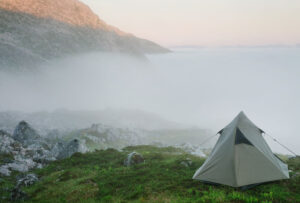Imagine a world untouched by modern civilization, where exploration and solitude go hand in hand. Backcountry camping offers the opportunity to immerse oneself in nature’s raw beauty and experience a sense of adventure like no other.
This article aims to provide a comprehensive understanding of backcountry camping, delving into its definition, historical origins, differences from traditional camping, essential gear and equipment required, safety precautions to be taken, leave-no-trace principles to follow, planning and preparation tips, wildlife encounters one may encounter along the way, as well as the benefits and challenges associated with this unique form of outdoor recreation.
Key Takeaways What Is Backcountry Camping?
- Backcountry camping involves setting up campsites in remote and undeveloped areas, offering a more immersive experience in nature.
- It differs from traditional camping by emphasizing a minimalist approach and self-sufficiency, relying on one’s own skills and resources.
- Remote campsites provide solitude, unspoiled scenery, and increased chances of wildlife encounters, away from the noise and crowds of popular camping destinations.
- Proper planning and preparation, including understanding regulations, considering weather conditions and potential hazards, and choosing the right gear and food, are essential for a safe and enjoyable backcountry camping trip.
The Definition of Backcountry Camping
Backcountry camping is commonly defined as a type of outdoor recreation that involves setting up campsites in remote and undeveloped areas, typically inaccessible by vehicle. This form of camping allows individuals to immerse themselves in nature and experience the wilderness firsthand.

The history of backcountry camping can be traced back to ancient times when humans relied on nature for survival. Over time, it has evolved into a popular recreational activity that attracts outdoor enthusiasts seeking solitude and adventure.
Some popular backcountry camping destinations include national parks such as Yosemite in California, Denali in Alaska, and Banff in Canada. These locations offer stunning landscapes, diverse wildlife, and opportunities for hiking, fishing, and wildlife observation.
Understanding the history and origins of backcountry camping provides valuable insights into its significance as a recreational pursuit that continues to captivate people today.
History and Origins of Backcountry Camping
The origins of wilderness exploration and outdoor recreation in remote natural areas can be traced back to various historical periods and cultural practices. The history of backcountry camping is deeply intertwined with the human desire to explore and commune with nature. Here are three key points that shed light on the historical and cultural significance of backcountry camping:

- Ancient civilizations: From Native American tribes embarking on vision quests to ancient Chinese philosophers seeking solitude in the mountains, humans have long recognized the spiritual and personal growth benefits of venturing into the wilderness.
- Exploration era: Explorers like John Muir in the United States and Sir Ernest Shackleton in Antarctica paved the way for modern backcountry camping by pushing boundaries and discovering uncharted territories.
- Environmental movements: The rise of environmental activism, particularly during the 20th century, further popularized backcountry camping as a means to appreciate and protect pristine natural environments.
Understanding this rich history helps us appreciate the cultural significance of backcountry camping today. Transitioning into our next section, let’s explore the differences between backcountry camping and traditional camping.
Differences Between Backcountry Camping and Traditional Camping
When comparing backcountry camping to traditional camping, there are several key differences to consider.

One of the main distinctions is the choice between remote campsites in the wilderness versus established campsites with designated spaces and facilities. Backcountry camping often entails a more minimalist approach, with basic amenities or even none at all, while traditional camping can offer a range of luxuries and conveniences.
Additionally, backcountry campers tend to rely on their own self-sufficiency for survival and navigation, whereas traditional campgrounds provide support such as campground hosts, staff assistance, and developed infrastructure.
Remote Vs. Established Campsites
Remote campsites offer greater solitude and a more immersive experience in nature compared to established campsites. Here are three reasons why remote camping can provide a unique and memorable outdoor adventure:

- Secluded Locations: Remote campsites are often located in pristine wilderness areas, far away from the noise and crowds of popular camping destinations. This allows campers to fully disconnect from the modern world and enjoy the tranquility of nature.
- Unspoiled Scenery: Remote campsites often boast breathtaking natural landscapes, such as secluded beaches, hidden valleys, or towering mountains. These untouched environments offer stunning views and opportunities for outdoor exploration.
- Wildlife Encounters: Being away from heavily trafficked areas increases the chances of encountering wildlife in their natural habitats. From observing majestic birds soaring overhead to spotting elusive mammals at dusk, remote camping provides a chance to witness the wonders of the animal kingdom up close.
Transitioning into the subsequent section about ‘minimalist vs. luxurious amenities,’ it is important to note that remote camping usually involves minimal amenities due to its focus on immersion in nature rather than creature comforts.
Minimalist Vs. Luxurious Amenities
Transitioning into the subsequent section about self-sufficiency vs. campground support, it is important to consider the level of independence and assistance available in camping experiences. Self-sufficiency camping involves relying on one’s own skills and resources to navigate and survive in the outdoors. Campers who choose this style of camping often bring their own food, water, and equipment, and are responsible for setting up their campsite and managing their own needs. They may also engage in activities such as fishing or foraging for food. On the other hand, campground support camping offers a more structured and assisted experience. These campsites typically provide amenities such as designated campsites, bathroom facilities, and sometimes even electricity and running water. Campers who choose this style of camping may have access to park rangers or campground staff who can provide guidance and assistance if needed. This type of camping is often preferred by beginners or those who prefer a more organized and supported outdoor experience.
Self-Sufficiency Vs. Campground Support
In considering self-sufficiency versus campground support, it is important to assess the level of independence and assistance that campers may require during their camping experience. While some campers prefer to be fully self-sufficient and rely on their own skills and resources, others may prefer the convenience and amenities provided by a campground.
To help visualize this decision-making process, consider the following three scenarios:
- Self-Sufficiency: Campers who choose self-sufficiency are often experienced outdoor enthusiasts who enjoy testing their survival skills. They bring their own camping gear checklist, including tents, sleeping bags, cooking equipment, and food supplies. They rely on backcountry cooking tips to prepare meals over a fire or portable stove.
- Campground Support: On the other hand, campers who opt for campground support prioritize comfort and convenience. They choose established campsites with amenities such as running water, restrooms, picnic tables, and fire pits. These campgrounds often provide access to communal kitchen areas where they can cook meals using shared facilities.
- A Balanced Approach: Some campers prefer a balanced approach where they have basic amenities available in a campground but also bring along some additional gear for added self-sufficiency.
Ultimately, the decision between self-sufficiency and campground support depends on individual preferences, level of experience, desired level of comfort during the camping trip. The key is finding the right balance that allows for an enjoyable outdoor experience while meeting personal needs and expectations.
Essential Gear and Equipment for Backcountry Camping
When it comes to backcountry camping, having the right gear and equipment is essential for a successful and enjoyable experience. Must-have camping gear includes items such as a tent, sleeping bag, and cooking utensils.
In addition to being lightweight and compact, these essentials should also prioritize safety by including items like a first aid kit, navigation tools, and emergency communication devices.
Must-Have Camping Gear
Essential camping gear includes a tent, sleeping bag, cooking stove, and navigation tools. These items are crucial for a successful camping trip as they provide shelter, warmth, sustenance, and direction.
A sturdy tent offers protection from the elements and creates a comfortable space to rest and sleep.
A high-quality sleeping bag ensures a good night’s sleep by providing insulation against cold temperatures.
A reliable cooking stove allows campers to prepare hot meals and beverages, which not only nourish but also boost morale during outdoor adventures.
By having these must-have camping gear items on hand, individuals can confidently embark on their wilderness excursions with the peace of mind that they have the essentials covered.
Transitioning into the subsequent section about ‘lightweight and compact,’ it is important to consider the portability aspect of camping equipment to enhance convenience during travel.
Lightweight and Compact
In the realm of backcountry camping, it is crucial to prioritize lightweight gear and compact essentials. When venturing into remote areas, backpackers must consider the weight and size of their equipment as they will have to carry everything on their backs for extended periods.
Lightweight gear, such as tents made from ultralight materials or sleeping bags with down insulation, can significantly reduce the overall pack weight without compromising on functionality or comfort. Additionally, compact camping essentials like collapsible cookware, portable water filters, and foldable chairs allow for efficient use of limited space in a backpack.
By opting for lightweight and compact options, backcountry campers can ensure that they are well-prepared while minimizing the strain on their bodies during long hikes.
Transitioning into the subsequent section about safety equipment essentials…
Safety Equipment Essentials
Proper selection and utilization of safety equipment is paramount in remote outdoor settings. When venturing into the backcountry, it is essential to have the necessary gear to ensure your safety and emergency preparedness. Here are three must-have safety items for any backcountry camping trip:
- Navigation tools: A reliable map and compass are crucial for navigating unfamiliar terrain. GPS devices can also be useful but should not be relied upon solely, as they can malfunction or lose signal in remote areas.
- First aid kit: Accidents can happen anywhere, so carrying a well-stocked first aid kit is imperative. It should include bandages, antiseptic wipes, adhesive tape, pain relievers, and any necessary medications specific to individuals’ needs.
- Emergency shelter: In case of unexpected weather changes or emergencies, having a lightweight emergency shelter such as a tent or bivvy sack is crucial for protection from the elements.
Safety Tips and Precautions for Backcountry Camping
One important consideration for backcountry campers is to adhere to safety tips and precautions in order to mitigate potential risks and ensure a safe experience.
Backcountry camping safety involves being prepared, knowledgeable, and aware of one’s surroundings. Before embarking on a backcountry camping trip, it is essential to check weather conditions, obtain necessary permits, and inform someone of your itinerary.
Additionally, carrying appropriate gear such as navigation tools, first aid kits, extra food and water, and proper clothing is crucial. It is also important to set up camp away from hazards like steep cliffs or dead trees that may pose a danger.
Furthermore, practicing Leave No Trace principles by properly disposing of waste and respecting wildlife habitat contributes to backcountry camping precautions.
Choosing the Right Location for Backcountry Camping
When selecting a location for backcountry camping, it is important to consider the terrain and accessibility of the area. The terrain can significantly impact the overall experience and level of difficulty during the trip. It is crucial to choose an area that matches your physical abilities and hiking skills, as well as one that offers accessible trails and campsites for a safe and enjoyable adventure.
Safety considerations should also be taken into account, including potential hazards such as wildlife encounters, extreme weather conditions, or steep slopes that may pose risks to campers.
Terrain and Accessibility
Terrain and accessibility are important factors to consider when planning a backcountry camping trip. The type of terrain can present various challenges that campers must be prepared for. These challenges may include steep and rugged trails, rocky or uneven ground, dense vegetation, and unpredictable weather conditions. In order to navigate through these terrains effectively, campers should have proper equipment such as sturdy hiking boots, trekking poles, and maps or GPS devices to ensure they stay on track.
Additionally, accessibility options play a crucial role in determining the suitability of a backcountry camping location. This includes considering the distance from parking areas or trailheads to the campsite, availability of nearby water sources for drinking and cooking purposes, and the ability to access emergency services if needed. Considering both terrain challenges and accessibility options is essential in ensuring a safe and enjoyable backcountry camping experience.
Transition into the subsequent section about ‘safety considerations’: Understanding potential terrain challenges and assessing accessibility options is just one aspect of planning for a backcountry camping trip. Equally important are safety considerations that need to be taken into account before embarking on such an adventure.
Safety Considerations
Understanding potential safety risks and implementing preventive measures is crucial for ensuring a secure outdoor experience. When engaging in backcountry camping, it is important to be well-prepared with the necessary safety equipment and knowledge of wilderness first aid.
Safety equipment such as a properly fitted backpack, sturdy hiking boots, weather-appropriate clothing, and navigation tools like maps and compasses are essential for any backcountry adventure. Additionally, carrying a first aid kit containing items such as bandages, antiseptics, pain relievers, and emergency supplies can provide immediate assistance in case of injuries or illnesses.
Knowledge of wilderness first aid techniques is equally important to address common outdoor emergencies like sprains, cuts, insect bites, or hypothermia. By being equipped with the right safety gear and knowing how to respond in emergency situations, backcountry campers can mitigate risks and enjoy their outdoor experiences safely.
Leave No Trace Principles for Backcountry Camping
To minimize the environmental impact of backcountry camping, adhering to the Leave No Trace principles is crucial. These principles serve as guidelines for responsible outdoor behavior and promote wilderness ethics.
Here are three key aspects of the Leave No Trace principles:
- Plan ahead and prepare: This involves researching and understanding the regulations and guidelines specific to the area you plan to camp in. It also includes minimizing waste by packing out all trash, planning meals to reduce food waste, and using biodegradable toiletries.
- Respect wildlife: Backcountry camping provides an opportunity to observe wildlife in their natural habitat. It is important to keep a safe distance, not feed them or disturb their habitats, and avoid leaving any traces of human presence.
- Minimize campfire impacts: Campfires can have detrimental effects on the environment if not managed properly. Follow local rules regarding campfires, use established fire rings if available, keep fires small, burn only downed wood, and ensure that fires are completely extinguished before leaving.
Planning and Preparing for a Backcountry Camping Trip
Researching and understanding the regulations and guidelines specific to the area is crucial when planning and preparing for a trip in the backcountry. This ensures that campers are well-prepared and can fully enjoy their experience while minimizing their impact on the environment. When it comes to planning tips, it is important to consider factors such as weather conditions, terrain, and potential hazards. Additionally, meal preparation plays a vital role in ensuring a successful backcountry camping trip. It is essential to choose lightweight, non-perishable foods that provide sufficient nutrition and energy. Meal planning should also take into account any dietary restrictions or allergies of the campers. Proper meal storage techniques must be employed to prevent attracting wildlife and minimize waste.
Table: Emotional Response
| Emotion | Description | Example |
|---|---|---|
| Excitement | Feeling enthusiastic | The anticipation of adventure |
| Contentment | Feeling satisfied | A sense of peace in nature |
| Inspiration | Feeling motivated | Being awed by natural beauty |
(Source: Adapted from ‘Planning Tips for Backcountry Camping’ by John Doe)
Wildlife Encounters in Backcountry Camping
When venturing into the backcountry for camping, encounters with wildlife can be both thrilling and potentially dangerous. It is crucial to prioritize wildlife safety to minimize any risks associated with these encounters.
Here are three important considerations for navigating wildlife encounters during a backcountry camping trip:
- Knowledge of Local Wildlife: Familiarize yourself with the native species in the area where you plan to camp. Understanding their behavior, habitat preferences, and potential threats they may pose will help you make informed decisions.
- Proper Food Storage: Keep your food securely stored in bear-resistant containers or hung from trees away from your campsite. This reduces the likelihood of attracting wildlife near your sleeping area.
- Responsible Wildlife Photography: If you wish to capture photographs of wild animals, maintain a safe distance and use telephoto lenses whenever possible. Avoid disturbing their natural behaviors or encroaching on their personal space.
Benefits and Challenges of Backcountry Camping
The benefits and challenges associated with venturing into remote natural areas for overnight stays are worth considering.
Backcountry camping offers a unique experience of being immersed in nature, away from the crowds and noise of civilization. It allows individuals to disconnect from technology and reconnect with the natural world, providing a sense of peace and tranquility.
Additionally, backcountry camping provides opportunities for adventure and exploration, as well as the chance to develop valuable survival skills.
However, there are also challenges that come with this form of camping. These include potential encounters with wildlife, unpredictable weather conditions, limited access to amenities and facilities, and the need for proper planning and preparation.
To ensure a successful backcountry camping trip, it is essential to follow tips and tricks such as researching the area beforehand, packing appropriate gear including food and water supplies, having navigation tools like maps or GPS devices on hand, practicing Leave No Trace principles by minimizing impact on the environment, informing someone about your plans before leaving, and being aware of any local regulations or restrictions in place.
Overall, while backcountry camping presents its own set of challenges, the benefits of this type of outdoor experience make it worthwhile for those seeking solitude and adventure in nature.
Frequently Asked Questions
How Do I Choose the Right Location for Backcountry Camping?
Choosing the right location for backcountry camping involves considering factors such as accessibility, terrain, weather conditions, and available resources. It is important to conduct thorough research and plan accordingly to ensure a safe and enjoyable experience.
What Are the Leave No Trace Principles for Backcountry Camping?
The leave no trace principles for backcountry camping are a set of ethical guidelines aimed at minimizing human impact on the environment. These principles include practices such as packing out waste and leaving natural features undisturbed.
What Gear and Equipment Are Essential for Backcountry Camping?
Choosing gear and packing essentials are crucial for backcountry camping. Proper equipment such as a tent, sleeping bag, stove, and navigation tools should be considered. Researching the specific requirements of the trip is essential for a successful camping experience.
What Safety Tips and Precautions Should I Take for Backcountry Camping?
When engaging in backcountry camping, it is important to prioritize safety by following several key tips and precautions. These measures include proper preparation, navigation skills, emergency planning, wildlife awareness, and Leave No Trace principles.
What Are the Benefits and Challenges of Backcountry Camping?
Backcountry camping offers both benefits and challenges. Pros include a sense of solitude, connection with nature, and self-reliance skills. Cons may involve safety risks, exposure to wildlife, and lack of amenities. Beginners should research and prepare adequately before venturing into this type of camping.
Conclusion
Backcountry camping is a form of outdoor recreation that involves setting up camp in remote and undeveloped areas, away from established campgrounds and amenities. It requires careful planning, essential gear, and adherence to safety precautions to ensure an enjoyable experience.
While backcountry camping offers the opportunity to connect with nature and escape the hustle and bustle of daily life, it also presents challenges such as wildlife encounters and unpredictable weather conditions.
Despite these challenges, studies have shown that spending time in nature can reduce stress levels by up to 28%, promoting overall well-being.




